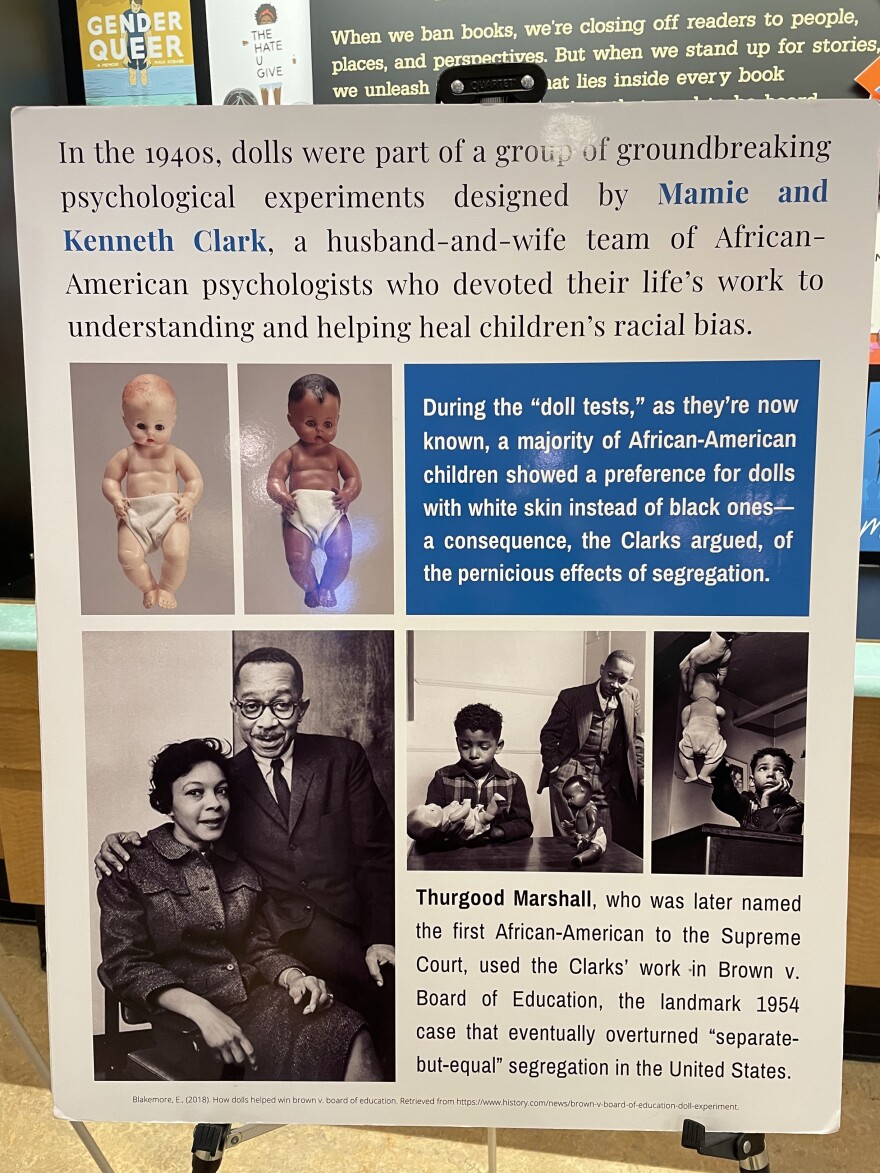When you remember the first doll you played with as a child, perhaps you become misty-eyed with nostalgia, or cringe at the time you cut off all her hair. But did you ever realize the part she played in your perception of yourself and your place in the world? An exhibit of Black dolls in downtown Buffalo toys with that very question. WBFO’s Holly Kirkpatrick visited the exhibit, which shares stories of Black history and the power of representation.
When Lisa Jacobs-Watson hears the word "royalty," she thinks of "what we consider in the Black culture as a Queen - a number one boss on top of her game."
"Recognizing Royalty" is the theme of this year’s Black Doll exhibit at the downtown branch of the Buffalo & Erie County Public Library. Jacobs-Watson is a doll collector and the curator of the event, which has been happening every February since 2020 in celebration of Black History Month.
"If I come across a doll that is dressed like a queen or a princess or gives that vibe, then I'm all about adding it to my collection," Jacobs-Watson said.

That collection currently totals 200 dolls, around 20 of which are on display in this year’s exhibit according to Jacobs-Watson.
There are fictional characters, such as Ariel from Disney’s "The Little Mermaid," as well as dolls that represent real-life inspirational Black women - figures such as civil rights activist Rosa Parks, journalist and activist Ida B. Wells, and NASA mathematician, Katherine Johnson. But Jacobs-Watson says her favorite section of this year's exhibit presents Black dolls either designed, created or manufactured by people of color.
"As a collector, as a curator, it's about the meaning behind the doll. And I do go a little bit deeper with who's manufacturing it and how are they manufacturing it? And is it accurately representing a person of color? Or is it just a white doll that you painted black and threw a wig on it? As opposed to a doll that was manufactured by the heart of someone who really wanted to appeal to a person of color, and wanted that parent and that child to truly embrace beauty, higher self-esteem, and know that they can reach the stars, regardless of what they look like."
And dolls can be a powerful indicator of a person’s self-perception. In fact, the exhibit tells the story of a scientific experiment that arguably proves just that.

In the 1940s, “the doll test” was carried out by husband and wife psychologists, Kenneth and Mamie Clark, in an attempt to study the development of self-esteem in Black children. In the test - which was carried out on many children separately - two dolls were placed in front of each child. One doll was Black and one doll was white. Then each child was asked a series of questions.
"For example, which is the nice doll? Which doll do you like? Which doll do you prefer? Those types of questions," Jacobs-Watson said. "And more often than not, the children preferred the white doll."
The Clarks found that prejudice, discrimination and racial segregation had negatively impacted how Black children saw themselves in the world. Over a decade later, the study underpinned the argument against racial segregation in schools in the 1954 U.S. Supreme Court case, Brown v. Board of Education. In a landmark ruling, the supreme court justices unanimously found that racial segregation in schools was unconstitutional.
"I always use that as a backdrop to get people to think about how far we've come with dolls, how far we've come with society. And then again, just tying it back to how effective dolls can be," Jacobs-Watson said.
Perhaps that effectiveness has played out in Jacobs-Watson's own life. She says that although Black dolls were scarce when she was a little girl, by the time her own daughter was playing with dolls in the 80s and 90s, lots more were available. And her collection was born.
“I just I jumped on it. I jumped on it. I bought the dolls. I loved the fact that my daughter could see these cool dolls. And it worked out.”
And when she says it worked out, she means it. Lisa’s daughter is Chair of the Erie County Legislature, April Baskin, who has also sponsored the exhibit.
"She came up with the idea, and we did this to celebrate Black history."
The Black doll exhibit is at the downtown branch of the central library through April 9.


